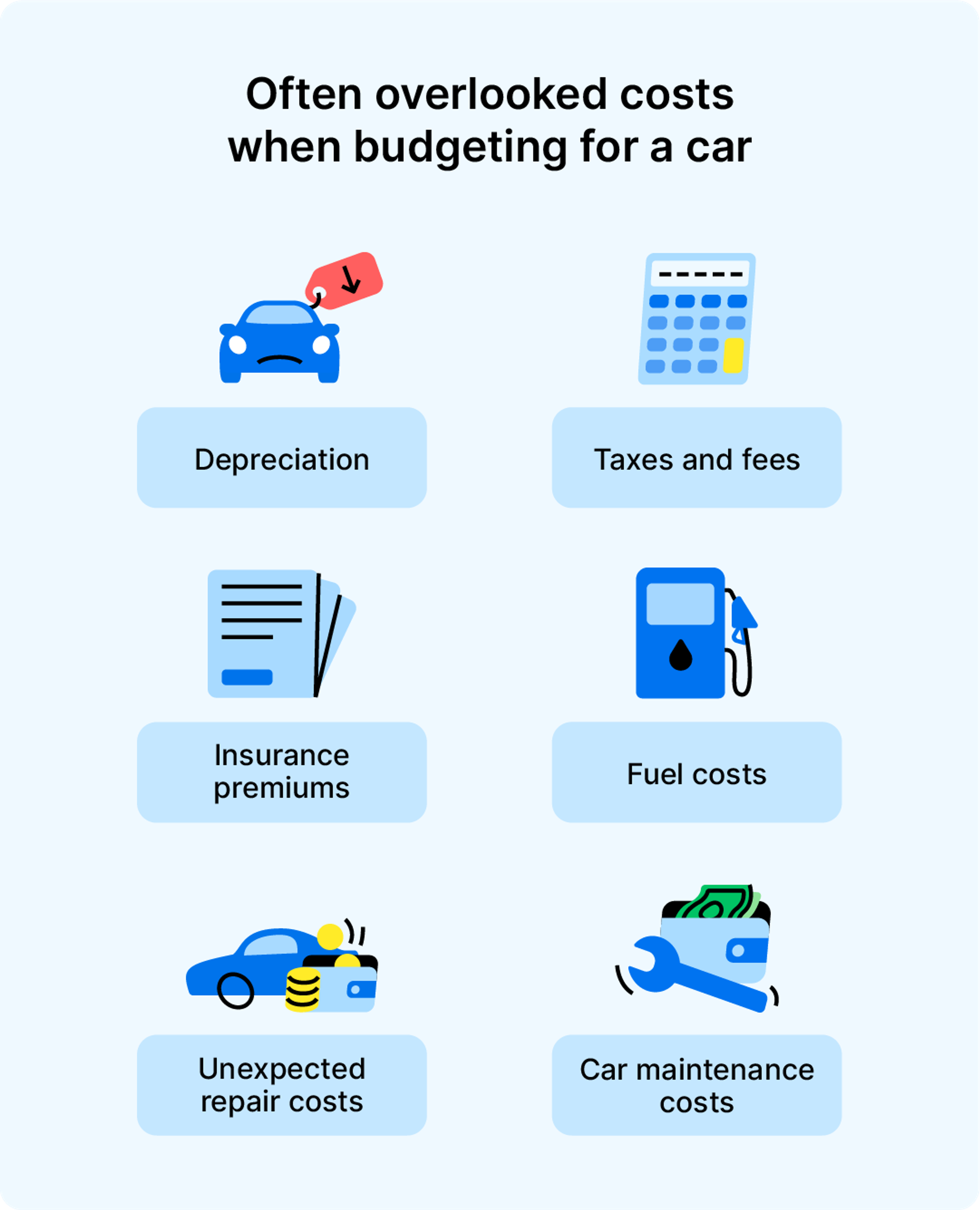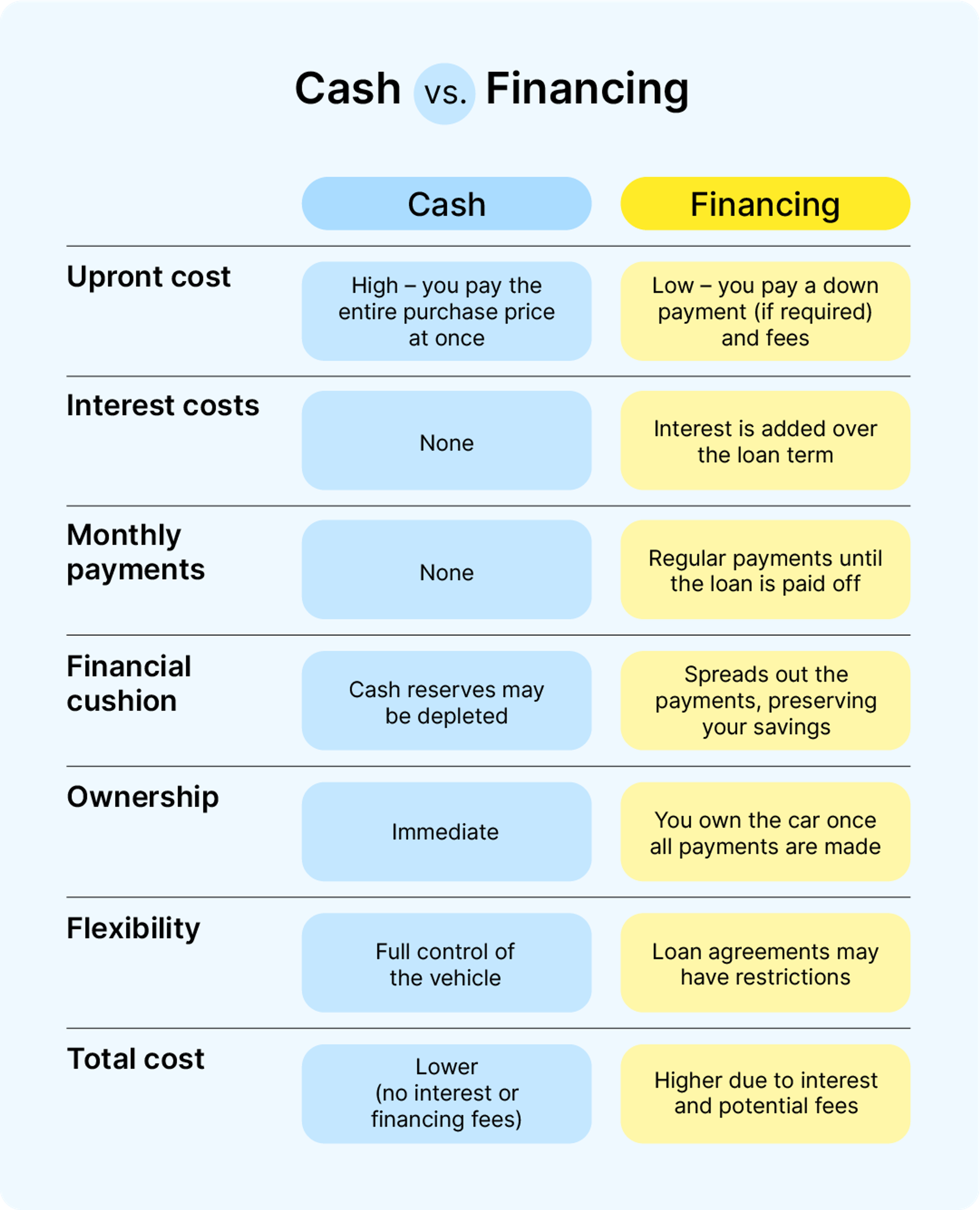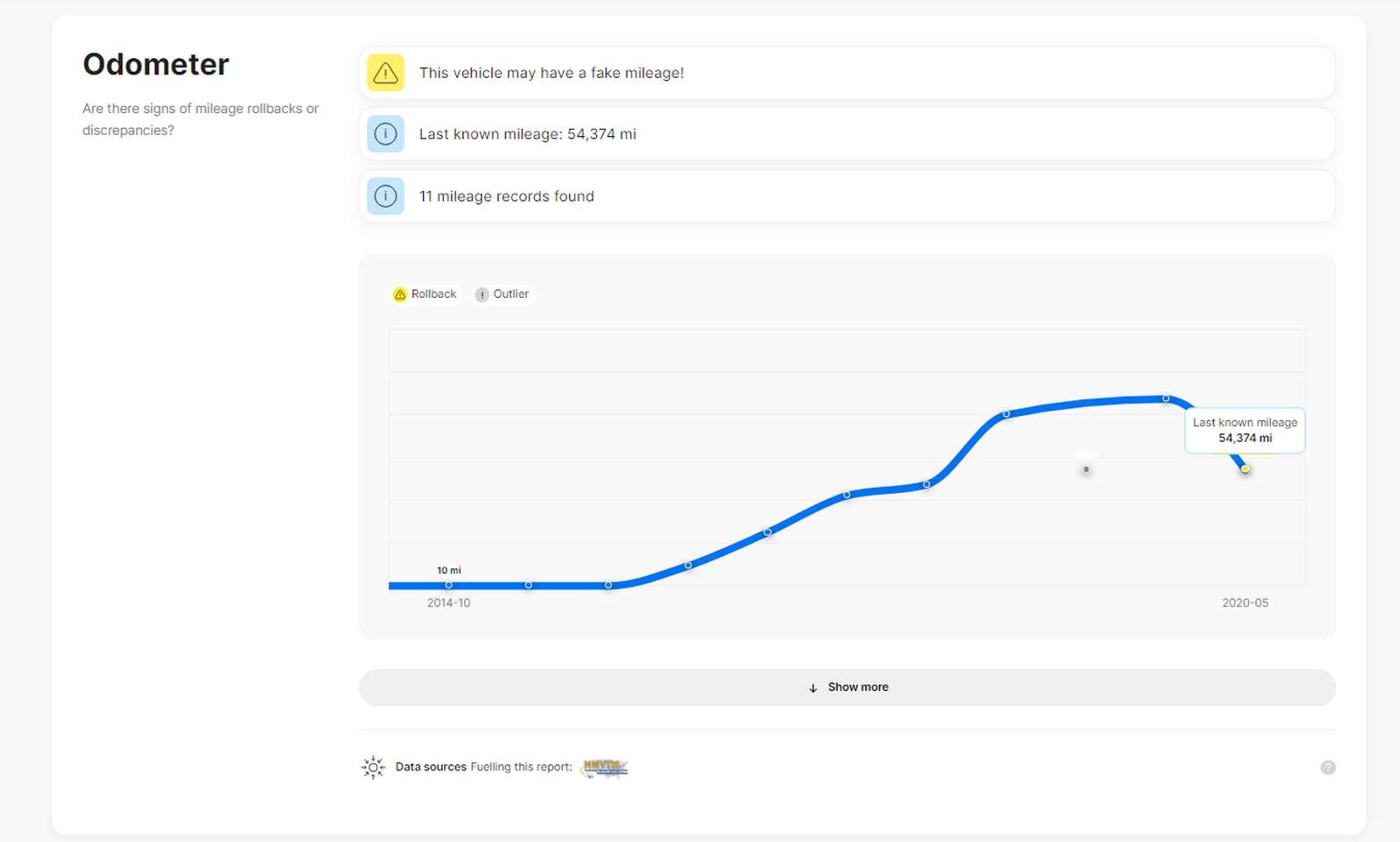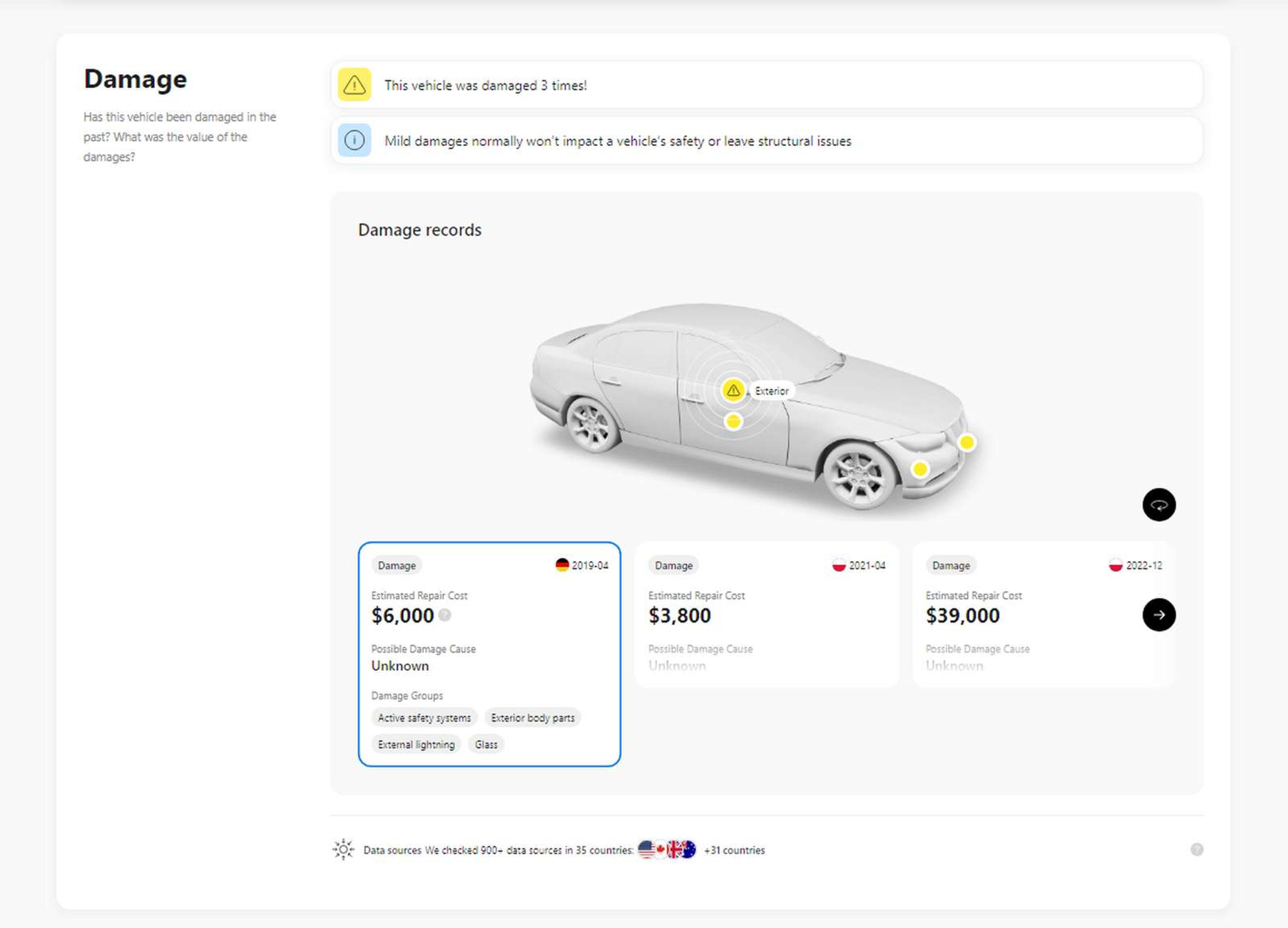Table of Contents
- 1. Consider what kind of vehicle you need
- 2. Set a budget
- 3. Decide how you're going to pay
- 4. Find a used car
- Buying from a private seller
- Buying from a dealership
- 5. Contact the seller
- 6. Get a vehicle history report
- 7. Test drive and examine the car
- 8. Get an independent technical inspection
- 9. Negotiate the price
- 10. Do the paperwork
- Car title
- Bill of sale
- Proof of sale
How to buy a used car: 10 simple tips
The used car market is filled with vehicles waiting for new owners. Yet buying a used car is not only exciting – it can also be quite challenging! After all, not all second-hand vehicles are what they appear to be at first sight.
To make the process simpler, follow these tips – they will help save you money and find a machine that will last.

Looks can be deceiving!
Don't risk your safety - check it with carVertical first
1. Consider what kind of vehicle you need
A luxury Lexus SUV or a sporty Volkswagen Golf GTI may look cool, but take a moment to switch off your emotions and think about what you actually need from a car.
What's your average yearly mileage? Do you really need a 4-wheel drive? Do you need space for more than 4 passengers? List every requirement and narrow it down to a vehicle that meets your criteria. Furthermore, consider the data found in car reliability reports. They could help determine which make and model to choose.
Additionally, consider fuel consumption, as it will help determine the type of powertrain you need. Never rely on the manufacturer's claimed figures, as they're never accurate. A study by Emissions Analytics suggests that the difference between the official fuel economy figures and their real-world results is about 24%.
- Choose a petrol-powered car if: You want the smoothest and most trouble-free vehicle ownership experience. These days, the choice of petrol cars is the widest, and if your car breaks down, you'll have no problem finding a professional to help you.
- Choose an electric vehicle if: You're concerned about the environment and are open to embracing innovation and changing your driving habits, as the electric car will require you to adjust how you use it. The initial investment requires a higher amount, but less frequent visits to workshops and lower fuel costs should make up for it in the long run.
- Choose a hybrid vehicle if: You prioritize fuel efficiency above anything else, especially in the urban environment, where vehicles consume the most fuel. Moreover, you can choose from two types of hybrids: self-charging ones and plug-in hybrids. The latter allows you to travel from 18 to 60 miles on electric power alone. This feature is handy for those who live in the environmental zones.
2. Set a budget
Decide how much you can afford to spend on your next car before you start exploring the market. You can set a realistic budget by evaluating these factors:
- Your finances. Review your income, expenses, and savings to determine how much you can comfortably spend.
- Vehicle price range. Check the prices of similar cars to establish a reasonable range for what you should expect to pay.
- Additional costs. Include taxes, registration fees, and any other costs associated with the purchase. Don’t forget to consider running costs, budget for maintenance, and potential repairs. For example, if you don’t want to exceed $10,000, you should search for a vehicle whose price is between $8000 and $9000.
- Insurance costs. An insurance company will evaluate your car's engine power, age, model, safety features, alarm system, and whether the car has been in an accident. Consult with an expert or check an online insurance calculator to learn which car would bring you better policy conditions.
- Maximum limit. Establish a clear upper limit on what you’re willing to spend and aim to stay below this amount.

3. Decide how you're going to pay
There are two ways to pay for a new or used car: paying the total amount upfront or getting approved for a loan (usually, either an auto loan or a consumer loan).
Whatever option you choose, keep in mind there's no right or wrong choice because each case is different.
- Choose cash (or wire) if: You don’t mind paying up-front and don’t want the long-term financial responsibility. Loans may let you get a better car, but in the long run, it also means you'll end up spending more.
- Choose financing if: You’d rather divide the financial burden over a period of time, or would like a better car than you can afford buying straight-up.

4. Find a used car
Don't buy the first car you like. Stay updated on the used car market until there's a model that suits your needs and budget. Keep track of:
- Online marketplaces
- Classifieds websites
- Used car auctions
- Car community groups
Additionally, explore options from both private sellers and dealerships to expand your choices. It’s important to weigh the advantages and drawbacks of each to make an informed decision.
Buying from a private seller
Buying from a private seller is often cheaper, which is great if you’re on a tight budget. They’re also typically more eager to sell, giving you more room for negotiation.
However, you won't receive a warranty, and once you've signed the title and paid, you're fully responsible for any issues or repairs. Also, lemon laws, which protect buyers from defective vehicles, rarely apply to private sales.
Buying from a dealership
Purchasing from a dealership is more convenient since you can check multiple vehicles in one location. It makes it easier to find something that fits your needs and budget.
At dealerships, you can purchase a certified pre-owned vehicle, which underwent comprehensive inspections and necessary repairs to keep it in excellent condition. Certified pre-owned vehicles also come with detailed inspection reports, including information on model-specific recalls, providing an extra layer of security and peace of mind compared to buying from a private seller.
5. Contact the seller
When you find a potential vehicle, don't rush out to see it. First, contact the seller.
This step is an excellent way to confirm the vehicle's specifications, ask why the car is for sale, discuss any mechanical issues it has, and find out the vehicle's accident history – accident damage significantly devalues a car.
More experienced sellers will say something that would intrigue you to see or even buy a car outright during a call. However, there's a chance that you'll hear information that wasn't in the ad, and that might change your mind.
Finally, never ask what the final price is. See a car for yourself and present yourself as a serious buyer.
6. Get a vehicle history report
Once buyers reach step 5 of the used car buying process, they typically start planning a trip to inspect the car in person. However, it’s important to first obtain a vehicle history report to help decide whether the trip is worth it or to learn about potential weak spots of the car so you can ask informed questions.
You can do this by running the vehicle's identification number (VIN) and through the VIN decoder.

A vehicle history report can reveal:
- Odometer readings: Verifying the accuracy of the odometer reading ensures you are paying a fair price based on the car's actual usage.
- Damage records: Cars are meant to be driven, so minor scratches or interior wear are expected. However, costly hidden damages can be a problem for future owners. Knowing the accident history helps buyers assess the risk of hidden issues and estimate needed repairs.
- Ownership information: Given that the average duration of used car ownership is approximately 8 years, a vehicle with multiple owners within a short span of time may raise concerns regarding its condition or reliability.
- Theft records: A vehicle history report can include an additional section that helps determine whether the vehicle has been reported as stolen, providing you with peace of mind and helping you avoid unknowingly purchasing a stolen vehicle.

All these and additional advantages of the vehicle history report, such as financial and legal status, title check, and safety information, will ensure you pay a fair price based on the actual vehicle history, not the dreams sellers are trying to sell you. Moreover, the report can provide valuable insights to help you negotiate a better price.

Check your VIN
Avoid costly problems by checking a vehicle's history. Get a report instantly!
7. Test drive and examine the car
This is the most exciting part of the vehicle buying process – sitting behind the wheel of the model you've researched so thoroughly.
A test drive is a must when buying a used vehicle because it lets you feel accustomed to the features and allows you to determine whether the vehicle's characteristics meet your needs.
Also, when you test drive a used car, consider the following:
- Arrange the test drive during daytime. It will help you to inspect the vehicle's bodywork.
- Listen for suspicious sounds coming from the engine.
- Ensure the check engine light goes out as soon as the engine starts.
- Ensure the clutch and steering wheel work properly. Try them out in as many ways as you can imagine.
- Ensure the vehicle's ride is straight and the car runs without veering to one side or another.
- Drive both around the city and on the highway.
- Find a safe place and try sudden braking. This will serve as a great test of the braking system.
- Find a hill to test the handbrake.
- Test the car on different road surfaces. Occasional uneven surfaces can help reveal faults in suspension components.
8. Get an independent technical inspection
Even if you plan to buy a used car from the dealership, which offers a mechanical warranty for one or two years, don't take it as a safety net if a vehicle breaks down in the future.
Instead, make an appointment at an independent technical inspection station or, even better, a workshop that specializes in specific makes and models. These workshops have the expertise and know-how to do their job properly.
It will cost you, but it’s worth it because you either know 100% the car is in good condition or you’ll find bargain power to reduce the price.
9. Negotiate the price
Not everyone is naturally skilled at negotiation. However, you can prepare by learning negotiation tactics, which can help you save money.
Start by researching the market to understand the fair value of the car you're interested in. Highlight any issues or flaws you find to strengthen your negotiating position. Insights from the vehicle history report can help you do it.
If you choose to purchase a used car from a dealership, make the dealers compete with one another. Find a couple of comparable offers if you can and try to get the best deal.
Additionally, sticking to your budget will help ensure you’re satisfied with your purchase. It can make the buying experience more positive and prevent overspending, which sellers might exploit if they sense you lack a clear budget.
Finally, don't purchase a car spontaneously. Wait for an initial offer and turn it down if it doesn’t meet your expectations, but be prepared to justify your decision.
10. Do the paperwork
Compiling all required documentation is the last stage in purchasing a second-hand vehicle.
Car title
The car title is the most crucial document when purchasing a vehicle.
The car's brand, model, year, and vehicle identification number are all listed on the title, which serves as legal proof of ownership.
Bill of sale
Some states require the seller to present a bill of sale to the buyer. A bill of sale typically includes information like a car’s VIN, the detailed description of a vehicle, the date of sale, and the purchase price. It should be signed by both parties when the car is sold.
Unlike the title transfer, a bill of sale doesn’t legally transfer vehicle ownership. Instead, it outlines the conditions of the sale and serves as a receipt for the buyer and a waiver of liability for the seller. Even if a bill of sale is not required in your state, it’s wise to fill one.
Proof of sale
After purchasing your car successfully, there's one more form that you should fill. Some states demand that you notify the DMV about a car purchase within a certain amount of time.
For instance, in California, vehicle sellers have 5 days to finish a Notice of Transfer and Release of Liability form.
Ensuring that all these documents are completed and submitted properly will help finalize your purchase and ensure a smooth transition of ownership. With everything in place, you’re ready to enjoy your new vehicle with peace of mind.
FAQ
Is it ever a good idea to buy a used car?
Yes. A used vehicle allows you to buy a modern car at a fraction of the cost of a new one. Also, it will allow you to avoid costly depreciation and spend less on insurance.
What's the best age for a used car?
The best-used vehicle age is 3 to 5 years. These vehicles have already lost much of their value without losing much quality.
How much mileage is good on a used car?
The United States Department of Transportation Federal Highway Administration has said that the average annual mileage of a vehicle is 14,263 miles. It means the average vehicle mileage should be around 70,000 miles after 5 years.
Is it OK to buy a 10-year-old car?
Yes, of course. However, before you buy a 10-year-old car, inspect it thoroughly and then decide if it's worth the price.
Does age or mileage matter more?
Neither. The most important thing is how the last owner has maintained it. If they serviced the vehicle regularly, you shouldn't be worried if a car is 10 years old or if it has 100,000 miles on the odometer.